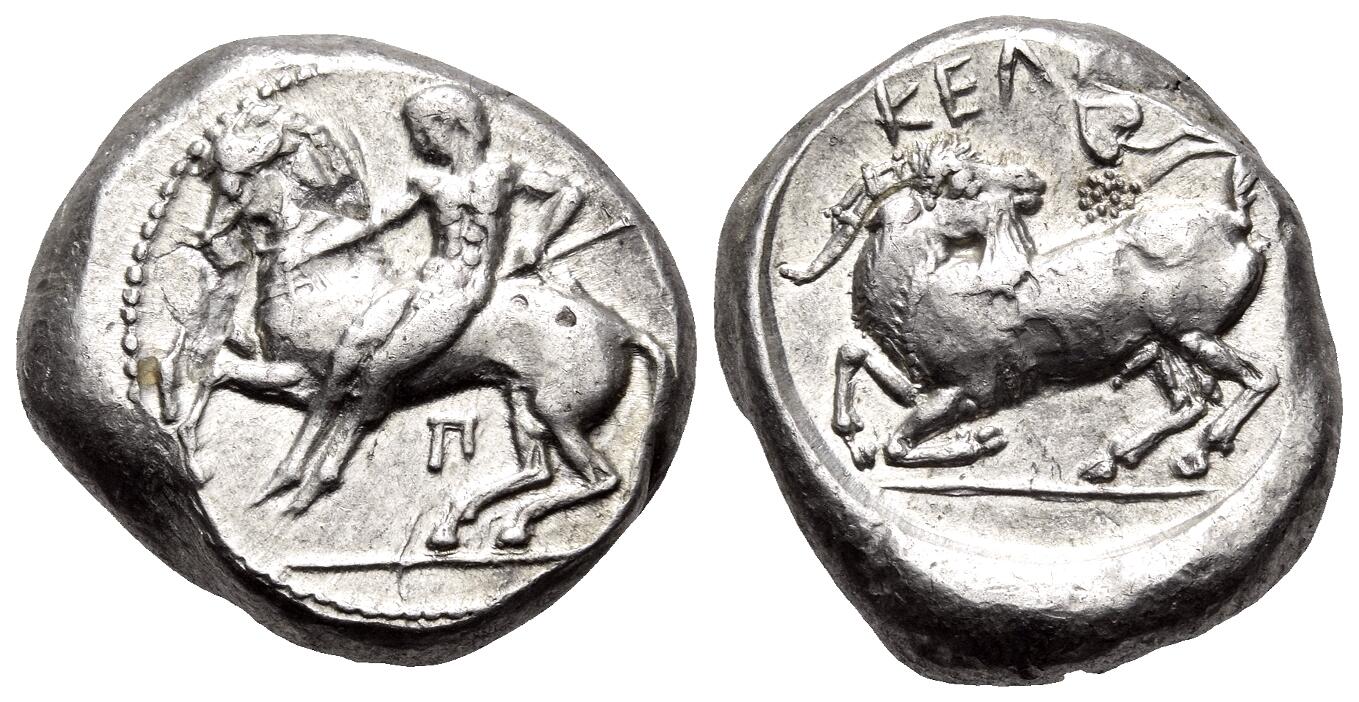20434 - Aspendus (double siglos hoplite/triskeles) over Celenderis (rider/goat) (CNG, EA 435, Jan. 2019, 106)
From SILVER
465 BCE - 430 BCE | ΕΣΤ
Location/history
| Sale(s)Sale(s) ᵖ: | Classical Numismatic Group, EA 435, 2 Jan. 2019, 106 | |
Overstriking coin
Description
| ObverseInscription or printing placed on the obverse.: | Warrior walking right, naked, wearing helmet, holding spear in right hand, shield attached on left arm. Between legs, pellet. | ReverseInscription or printing placed on the reverse.: | ΕΣΤ Triskeles of human legs. Behind, lion crouching left. All within incuse square. |
Mint and issuing power
| MintIdentifies the place of manufacture or issue of a numismatic object.: | Aspendus | Ancient regionAncient region. | Pamphylia | Modern countryModern country: Turkey | AuthorityIdentifies the issuing power. The authority can be "pretended" when the name or the portrait of X is on the coin but he/she was not the issuing power. It can also be "uncertain" when there is no mention of X on the coin but he/she was the issuing power according to the historical sources: | Persian Empire |
Chronology
| FromIdentifies the initial date in a range assigned in a numismatic context. 465 BCE toIdentifies the final date in a range assigned in a numismatic context.. 430 BCE | Classical 480-323 BC |
Physical description
| MetalThe physical material (usually metal) from which an object is made.: Silver |
WeightWeight of the numismatic object (in grams). in grams: 10.8010.8 g <br />10,800 mg <br /> | DenominationTerm indicating the value of a numismatic object. Examples: tetradrachm, chalkous, denarius.: double siglos |
AxisDescribes the directional relationship between the obverse and reverse of a numismatic object.: 11 mm <br />0.1 cm <br /> |
| DiameterDescribes diameter of an object (in mm).: 1919 mm <br />1.9 cm <br /> | StandardStandard.: Persian | ||
References
| Coin referenceReference of the Coin: | https://www.dismountingrider.info/coin-catalogue/overstrikes/#Aspendos-2 | Coin series referenceReference to coin series study: | Babelon 1901-19321Babelon 1901-1932, Tome 1, Part 2, p. 526-530, n° 869-70, SNG von Aulock Pamphylien2SNG von Aulock Pamphylien, n° 4482-3, SNG France 33SNG France 3, n° 12-13 |
| Coin series web referenceCoin series web references: | |||
Overstruck type
Description
| ObverseInscription or printing placed on the obverse.: | Rider, holding whip, dismounting from horse prancing to left | ReverseInscription or printing placed on the reverse.: | KEΛEN (Greek) Goat kneeling left, head turned to look back, above, ivy sprig with leaf and flower |
Mint and issuing power
| MintIdentifies the place of manufacture or issue of a numismatic object. ᵖ: | Celenderis | Ancient regionAncient region. ᵖ | Cilicia | Modern countryModern country: Turkey | AuthorityIdentifies the authority in whose name (explicitly or implicitly) a numismatic object was issued. ᵖ: | Persian Empire |
Chronology
| FromIdentifies the initial date in a range assigned in a numismatic context. 430 BCE toIdentifies the final date in a range assigned in a numismatic context.. 420 BCE | Classical 480-323 BC |
Physical description
| DenominationTerm indicating the value of a numismatic object. Examples: tetradrachm, chalkous, denarius. ᵖ: | double siglos |
References
| Coin type referenceReference to coin series study ᵖ: | Kraay 19624Kraay 1962 | ||
| Coin series web reference overstruckCoin series web references overstruck: | |||
Additional data
| Frequency of overstrikesFrequency of overstrikes: | frequent | Level of confidenceLevel of confidence of the identification: | sure |
| RemarksRemarks: | "overstruck on a stater of Kelenderis" | ||
References
- ^ Babelon, Ernest (1901-1932), Traité des monnaies grecques et romaines, Paris, E. Leroux
- ^ Sylloge Nummorum Graecorum. Sammlung v. Aulock. Pamphylien. 11 Heft (n° 4477-4893), Berlin, 1965.
- ^ Levante, Edoardo [with the collaboration of Peter Weiss] (2001), Sylloge nummorum graecorum. France. 3, Département des monnaies, médailles et antiques : Pamphylie, Pisidie, Lyaconie, Galatie, Paris-Zürich, Bibliothèque nationale de France-Numismatica Ars Classica, XXXIV + 293 p. and 146 pl.
- ^ Kraay, Colin M. (1962), "The Celenderis Hoard," Numismatic Chronicle, 7 (2), p. 1-16, pl. 1-2.

